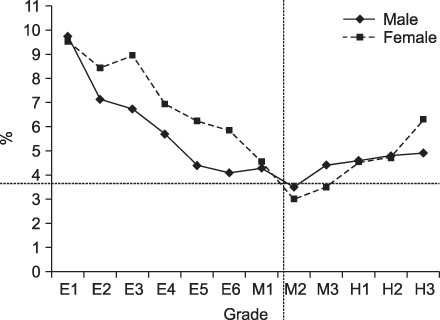Korean J Pediatr Gastroenterol Nutr.
2011 Dec;14(Suppl 1):S55-S60. 10.5223/kjpgn.2011.14.Suppl1.S55.
Underweight in Adolescents
- Affiliations
-
- 1Department of Pediatrics, Kangwon National University School of Medicine, Chuncheon, Korea. shimjo1@hanmail.net
- KMID: 1451150
- DOI: http://doi.org/10.5223/kjpgn.2011.14.Suppl1.S55
Abstract
- There are few studies of underweight in adolescents in Korea and other developed countries. According to the recent surveillance in Korea, prevalence of underweight in adolescents is lower than those in developing countries, and higher than those in developed countries in Northern Europe. This article reviews the problems, diagnosis, and nutritional support of underweight in adolescents.
Keyword
MeSH Terms
Figure
Reference
-
1. Rosenn DW, Stein LL, Jura MB. Differentiation of organic from nonorganic failure to thrive syndrome in infancy. Pediatrics. 1980. 66:698.
Article2. Moon JH, Kim JY, Beck NS. Clinical manifestation of children with failure to thrive. Korean J Pediatr Gastroenterol Nutr. 2000. 3:68–74.
Article3. Wang Y, Monteiro C, Popkon B. Trend of obesity and unerweight in older children and adolescents in the United States, Brazil, China and Russia. Am J Clin Nutr. 2002. 75:971–977.
Article4. Yngve A, Bourdeaudhuij I, Wolf A, Grjibovski A, Brug J, Due P, et al. Differences in prevalence of overweight and stunting in 11-year old across Europe. Eur J Public Health. 2008. 18:126–130.
Article5. Kelishadi R, Ardalan G, Ghelratmand R, Majdzadeh R, Hosseini M, Gouya MM, et al. Thinness, overweight and obesity in a national sample of Iranian children and adolescents. Child Care Health Dev. 2008. 34:44–54.6. 2008 National health statistics. Korean Center for Disease Control and Prevention. http://knhanes.cdc.go.kr/.7. Lee Y, Shin HK, Choi BM, Eun BL, Park SH, Lee KH, et al. A survey of body shape perception and weight contol of adolescent girls in three areas of Korea. Korean J Pediatr. 2008. 51:134–144.
Article8. Shim JO. 2009 Statistics of school health examination survey. 2009. Ministry of Education, Science and Technology;63–69.9. Rho YI, Kim KH, Yang ES, Park YB, Park SK, Park J, et al. Prevalence of obesity and its relationship to diet on elementary students. Korean J Pediatr Gastroenterol Nutr. 2000. 3:181–187.
Article10. Panagiotopoulos C, McKrindle BW, Hick K, Katzman DK. Electrocardiographic findings in adolescents with eating disorders. Pediatrics. 2000. 105:1100–1105.
Article11. Lo Sauro C, Ravaldi C, Cabras PL, Faravelli C. Stress, hypothalamic-pituitary-adrenal axis and eating disorders. Neuropsychobiology. 2008. 57:95–115.
Article12. Rosen DS. Clinical report-Identification and management of eating disorders in children and adolescents. Pediatrics. 2010. 126:1240–1253.
Article13. Kim YH. Pediatric medical nutrition. 2007. Seoul: Korea Medical;269–282.14. Mehler PS, Winkelman AB, Andersen DM, Gaudiani JL. Nutritional rehabilitation: practical guidelines for refeeding the anorectic patient. J Nutr Metab. 2010. 1–7. Epub.
Article15. Peterson KE, Washington J, Rathbun JM. Team management of failure to thrive. J Am Diet Assoc. 1984. 84:810–815.
Article16. Abrams SA. Dietary guidelines for calcium and vitamin D: a new era. Pediatrics. 2011. 127:566–568.
Article
- Full Text Links
- Actions
-
Cited
- CITED
-
- Close
- Share
- Similar articles
-
- A Study of Underweight Adolescents Characteristics and Health Promotion by Applying Data Mining Techniques
- Adolescents' Satisfaction of Body and Self-Esteem According to Obesity and Subjective Perception of Body: Verification of Moderating Effect of Sex
- Comparison of Life Style, School Achievement and Snaking Behaviors among Underweight and Overweight Adolescents
- Body Mass Index, Body Weight Perception, and Depressed Mood in Korean Adolescents
- The Prevalence of Obesity and Underweight in Adolescents in Incheon Area and the Relationship between Serum Cholesterol Level and Obesity


